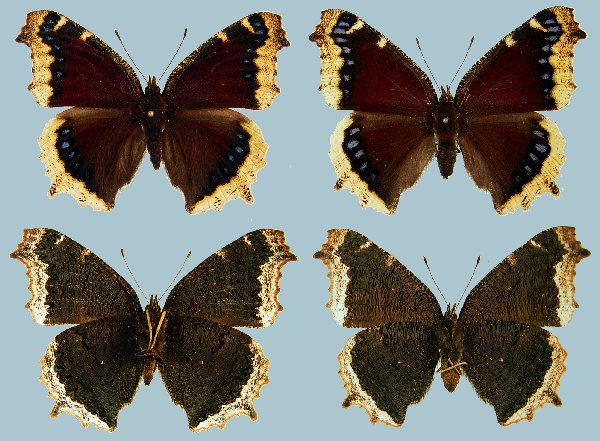Nymphalis antiopa

Photo Life History: Nymphalis antiopa
Habitat: Mountain Canyons; Pinyon Juniper; Agricultural Areas; Valley Wet Meadows; Mountain Hilltops; Valley Lakes & Rivers; Desert Washes; Lower Sonoran Desert; Urban-Suburban;
Host Plants: Salix amygdaloides; Salix exigua; Ulmus pumila; Celtis reticulata; Salix babylonica
Suitable Lab Host Plants: Populus angustifolia; Populus tremuloides (Almost any elm, hackberry, willow, or cottonwood.)
How to Find Female Butterflies: Click here. Caution: Collecting live females for eggs in the fall or early spring is unproductive because they have not yet mated. The time to collect post-diapause females is not until spring when host plants are leaved out. (See notes below.)
Caring for Live Female Butterflies: Nectaring techniques
Methods of Female Oviposition: Open Screen Cages; Potted Plant Sleeves (Females prefer to lay large clutches of eggs around the tree stems)
How to Find Eggs: Look around the stems or twigs of trees. Not very productive unless adults are abundant.
How to Hatch Eggs: Consolidate eggs into one container.
How to Find Caterpillars in the Field: Look for Caterpillar Strip Patterns. Caterpillars feed gregariously and can create very noticeable strip patterns on the host plant.
How to Find Pupae in the Field: Larvae will sometimes pupate on the tree; but, not reliably so.
Caterpillar setups: Open terrariums; Open Bucket; Netted Sleeve. Click here to watch a video on how to raise mourning cloaks using netted sleeves.
Larva to Pupa: Caterpillar silks to leaf or twig; creates and attaches cremaster; hanging as a J before pupating.
Number of Broods per Year: 1-3
Overwintering Stage: Adult
Overwintering Strategies:
Post-Hibernation Strategies:
Avoiding Diapause Techniques:
Disease Prevention: Change out host plant and remove frass every four to five days in an open bucket or open terrarium setup.
Emergence: Emergence Container
Field Notes: Post-diapause females collected in the fall or late winter/early spring usually have not yet mated. (Unless, you found a female in the sunbelt where willows have already leafed out.) I was fortunate to collect a female on 30 May 2004 in American Fork Canyon, Utah County, Utah, that was flying around the interior of a willow tree next to the river. She obviously had mated and was looking to lay eggs. When I sleeved her on my willow tree, she laid a large clutch of eggs around a narrow stem of the tree.

